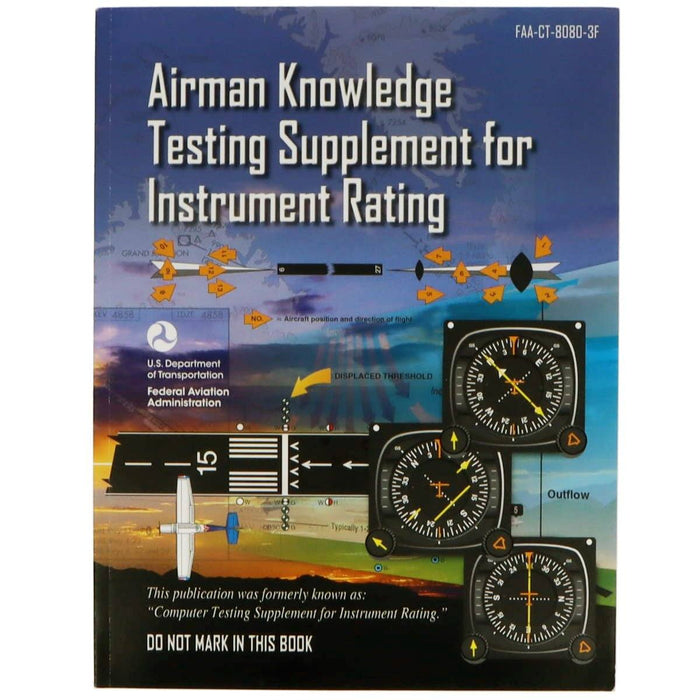You won’t get far if you don’t know where you’re going, and if you fly in the wrong direction, it could be disastrous. This is why an accurate directional device like a heading indicator is such an important aircraft instrument.
Today we’re going back to ground school basics as we talk about what a heading indicator is, how it works, and what type of errors it is prone to (plus how to deal with them).
Ready for an instrumentation refresher? Let’s get started.
What is a heading indicator in an aircraft?
The heading indicator (HI) is a primary flight instrument that is part of the basic aviation “six pack.” You may also hear this instrument referred to as the Directional Gyro (DG) or Directional Indicator (DI). The heading indicator displays the heading, or direction the aircraft’s nose is pointed in relative to magnetic north.
(The Figure in the Image used is by: U.S. Dept. of Transportation, FAA - Pilot's Handbook of Aeronautical Knowledge, FAA-H-8083-25B, Public Domain)
How does a heading indicator work?
As a gyroscopic flight instrument, the heading indicator works using a gyroscope. The gyro is usually driven by suction from a vacuum pump but can also receive direct current from the electrical system on some planes.
Once the gyro is “spooled up,” it spins at a rate of nearly 24,000 rpm. The gyro will want to remain stable with its axis pointing in the same direction as the two gimballed rings around it allow for free movement.
Before takeoff, pilots align the heading indicator gyro’s axis with a known heading (provided by the magnetic compass).
During flight, the heading indicator then measures how much the aircraft has turned around the stable axis of the gyro. This pivot alters the heading reading on the heading indicator gauge.
How to read a heading indicator
The heading indicator is easy to read and (when properly calibrated) gives your magnetic heading in degrees just like a magnetic compass.
The face of the heading indicator gauge features a little airplane shape that sits over a 360-degree compass card. The nose of the plane points to the aircraft’s current heading.
A vertical line called a lubber line extends from the nose of the plane and intersects with the heading indicator hash marks to help you get a more precise reading.
Your indicator’s compass card may include letters denoting each of the eight cardinal points at their corresponding magnetic heading.
The magnetic headings and related cardinal points are:
- North: 000°/360°
- North East: 045°
- East: 090°
- South East: 135°
- South: 180°
- South West: 225°
- West: 270°
- North West: 315°

Pro Tip: Remember that in aviation, all headings are written and spoken using three decimal places. That means that even two-digit headings like 90° are written as “090°” and read as “zero-niner-zero degrees.”
Is a heading indicator the same as a compass?
A magnetic compass has been the primary instrument used in aircraft for years to determine or establish heading. Heading indicators and compasses are similar since both provide the heading of the aircraft. In straight and level flight, they will both be accurate (provided you reset the heading indicator – more on that later).
The big difference between the two comes from the source of their data. An aircraft compass is liquid filled and uses a magnetic needle that points to magnetic north, much like outdoor land-based compasses.
The standard heading indicator, on the other head, gets its directional reference from the magnetic compass, then holds its position using the gimballed gyroscope.
Why is the heading indicator important?
The magnetic compass is a useful tool that works well during straight and level flight, but it has several innate errors when it comes to use for aircraft navigation.
First there is dip error or “dip” which is created by the downward slope of the Earth’s natural magnetic field. This dip will cause the compass to be inaccurate during maneuvers such as banking or during acceleration and deceleration. Turbulence can also temporarily throw a magnetic compass off.
Because it is a gyroscopic instrument, the heading indicator is not affected by banks, turbulence, and dip errors like the magnetic compass is. Many pilots use both a magnetic compass and a heading indicator in tandem.
Heading indicator errors
Although it doesn’t share the same issues as the magnetic compass, your heading indicator isn’t 100% perfect either. Like any other instrument, it is subject to failure and error. Several things can go wrong with your HI.
For starters, good old human error. A student or pilot may forget to check gyro power and reset the heading indicator before take-off. *Insert reminder to always follow your pre-flight checklist*. You can also forget to uncage the gyro after realignment. (More on this later, but for now just remember to raise your situational awareness so you aren’t the cause of indicator errors).
Second, if the vacuum pump that provides suction for the heading indicator’s gyro fails, the HI will also stop working. A lack of direct current to an electrically powered gyroscope will cause the same problem.
Finally, there are two known factors that cause the heading indicator to drift off its calibration to magnetic north—mechanical drift and apparent drift.

Mechanical drift
Over time, the small amounts of friction within the heading indicator’s gimbal components build up. They cause accumulated heading errors if not corrected. These types of errors are called mechanical or real drift.

Pro Tip: Worn bearings on older heading indicators can increase the amount of friction-created drift your indicator experiences.
Apparent drift
Pilots navigate using ground references. Since the earth is rotating at a rate of 15-degrees per hour, our ground reference points move too. If we do not reset our heading indicator, the gyroscope will drift by an average of 4° every fifteen minutes. This is called apparent drift or precession.
The closer you are to the North or South Pole, the greater the hourly apparent drift. For example, at the equator, apparent drift is 0° per hour. At the North Pole, however your indicator will drift at a rate of 15° per hour.
If you’re a fan of mathematical equations, you can calculate your apparent drift using the formula:
Drift per hour = Aircraft altitude x 15
(For the rest of us, just remember to realign your heading indicator every fifteen minutes to correct for this phenomenon.)
How to align the heading indicator
The gyros in more advanced flux gate system heading indicators are “north seeking.” This type of system uses a sensor to continuously monitor the earth’s magnetic field and a servomechanism that corrects the heading indicator without any pilot input needed. You may also hear this set-up referred to as a “slaved gyro.”
If you’re flying with a traditional heading indicator, however, you will need to perform a manual alignment. The rule of thumb is to reset your heading indicator to match your compass in 15-minute intervals.
To perform a manual heading indicator alignment:
- Push the heading adjustment knob on the front of your heading indicator in to “cage” or “slave” your gyro so the gimbal stops moving during your alignment (if applicable, depending on your indicator).
- Chose a reference point straight ahead of your aircraft.
- Fly straight and level toward the chosen reference point.
- Read the magnetic compass heading.
- Keep your aircraft’s nose aligned with the reference point.
- Adjust the reading of the heading indicator so it matches that of the magnetic compass.
- Confirm that the aircraft heading is still toward the chosen reference point.
- Pull the heading adjustment knob out to release the gimbal lock (if applicable).

Pro Tip: Remember that step #8 is very important. If you forget to pull the knob back out, your heading indicator reading will remain the same as it was when you pushed the knob in regardless of how much your true heading changes.
What to do if your heading indicator fails or you need to correct errors
If you forget to reset your heading indicator before takeoff, other than remembering to pay better attention to your checklist next time, the simplest thing to do is to realign the indicator with your compass once you reach a straight and level attitude. Remember to keep making periodic corrections for mechanical and apparent drift throughout your flight.
If a vacuum pump failure renders your heading indicator inoperative, fall back to your compass. Most pilots also have chart plotters and tablet or phone apps with heading indicators that can be used as a backup to your dedicated onboard heading indicator.
Heading vs course over ground
Before we wrap this up, we want to cover one of the heading-related concepts that can trip up new student pilots—the relationship between your heading and your course over ground.
Remember that your heading is the direction the nose of your aircraft is pointing in. You may or may not be “making way” in that direction. A course indicator is what tells you the direction you’re flying in. In fact, the only time your heading and course will match is in completely still air.
If, for example, you are experiencing a strong crosswind component, your nose can stay pointed toward your heading even as you get pushed off-course. To compensate, you’ll need to pull out your E6B flight calculator and enter the crosswind component factor, then adjust your heading so you arrive at your destination.
Frequently Asked Questions
- Why are heading indicators necessary for flight?
The heading indicator(also known as the directional gyro) is important for pilots. They provide real-time information about the aircraft’s heading, allowing for accurate navigation and control of the aircraft’s direction indicator.
2. What is the significance of the Earth’s magnetic field in relation to the heading indicator?
The Earth’s magnetic field serves as the main reference for heading indicators. The instrument uses this magnetic field to determine the aircraft's heading in relation to the Earth’s North and South poles.
3. How reliable are heading indicators in flight?
Heading indicators are generally a reliable instrument, but can experience drift as a result of the gyroscope and cause small inaccuracies. Therefore, the pilot will need to align the heading indicator with the magnetic compass on a regular basis throughout the flight. A well-prepared pilots will want to be aware of mechanical and apparent drift.
4. Can heading indicators be affected by turbulence or abrupt maneuvers?
Yes, turbulence or abrupt maneuvers can cause temporary errors in heading indicators. Newer aircraft are designed with damping mechanisms to help minimize these effects and quickly return to accurate readings.
5. Are heading indicators affected by the aircraft’s attitude or bank angle during flight?
Yes, the directional gyro (or HI) can be influenced by the aircraft’s attitude or bank angle. When the aircraft is in a turn or maneuvering, the gyroscope inside the heading indicator might experience precession, which causes a temporary error in the displayed heading.
6. Are heading indicators the only instruments used for navigation during flight?
While the heading indicator is important, modern aircraft utilize a combination of navigation instruments, including GPS, inertial navigation systems, and magnetic compasses, to ensure redundancy and enhance navigational accuracy.
7. Do pilots need to adjust heading indicators during flight?
Yes, heading indicators may need period adjustment during flight due to gyroscopic drift.
8. How do pilots cross-check heading indicators with other flight instruments?
A cross-check involves comparing the reading from the directional gyro with data from the other instruments, such as the GPS and attitude indicators.
Next steps
Student pilots, are you preparing to earn your instrument rating? Add the ASA Airman Knowledge Testing Supplement – Instrument Rating to your must-have study materials list. This IFR figure book is the exact same one you’ll see when taking the FAA Knowledge Exam at a computer testing center. It even includes full-color charts to help you learn and retain the information better.

|
ASA Airman Knowledge Testing Supplement - Instrument RatingThe ASA Airman Knowledge Testing Supplement for Instrument Rating. This book, which is called a "figure book," is the same one issued during the FAA Knowledge Exams at computer testing centers, complete with full-color charts. |
You can also check out the articles linked below for more deep dives on aircraft instruments.














